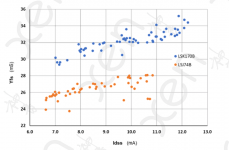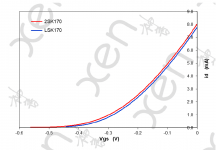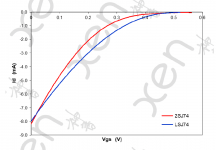I have a spare unopened set from the diyAudio store if you are interested to take over from me. PM me.Does anyone know if these going to be available in the store again soon?
That's a lot of jfets you need. Should you also be interested in the original Toshibas,
you can try contacting Spencer (FET Audio | Hi-End Audio Projects)
you can try contacting Spencer (FET Audio | Hi-End Audio Projects)
Does anyone know if these going to be available in the store again soon?
they still sell 8 of each per grade in the store...you should be able to match the pair to some degree
they still sell 8 of each per grade in the store...you should be able to match the pair to some degree
I prefer to buy them that way. Usually get some close enough to work with some left over to match later.
Good evening!
I need an advise regarding the LINEAR SYSTEMS JFETS LSJ74 and LSK170. Unfortunately I’m a beginner in this field and I think I’ve made a mistake. I intend to build the F6 amp and I have ordered LSJ74 Grade A and LSK170 Grade B.I had the feeling they have to be matched only on each type of JFET ( 2 matched LSJ74 and 2 matched LSK170) , now I realize that all 4 of them have to be matched. Am I right? In this situation do I have any chance to match them somehow? what is the range anyway (10 %...)?
Thank you
Regards
PS: sorry for my English …it’s another thing that I have to improve
I need an advise regarding the LINEAR SYSTEMS JFETS LSJ74 and LSK170. Unfortunately I’m a beginner in this field and I think I’ve made a mistake. I intend to build the F6 amp and I have ordered LSJ74 Grade A and LSK170 Grade B.I had the feeling they have to be matched only on each type of JFET ( 2 matched LSJ74 and 2 matched LSK170) , now I realize that all 4 of them have to be matched. Am I right? In this situation do I have any chance to match them somehow? what is the range anyway (10 %...)?
Thank you
Regards
PS: sorry for my English …it’s another thing that I have to improve
Idss and Yfs Distributions
For those who no longer have access to NOS Toshiba’s JFETs, the Linear System equivalent (LSK170 and LSJ74) becomes the only alternatives.
However, little data or statistics have been published about these substitutes.
Earlier, we have published some noise data for the LSK170 compared to the original 2SK170.
Recently, we have gained access to 50 pairs of the LS devices (B grade), and have taken some measurements of them.
So here they are.
They would no doubt be of interest to those who intend to use them instead of paying extra for the NOS Toshiba’s.
Firstly the Idss and Yfs distribution of both the N.channel and P-channel JFETs.
As can be seen, there is quite a bit of spread in Yfs for the same Idss.
This is especially so for the LSJ74.
Furthermore, while the LSK170s have very similar Yfs as the Toshiba’s, the LSJ74s have much lower Yfs (~25mS) than the 2SJ74 (~40mS).
This should be taken into account when trying to substitute the 2SJ74s directly with 2SK170s.
Patrick
.
For those who no longer have access to NOS Toshiba’s JFETs, the Linear System equivalent (LSK170 and LSJ74) becomes the only alternatives.
However, little data or statistics have been published about these substitutes.
Earlier, we have published some noise data for the LSK170 compared to the original 2SK170.
Recently, we have gained access to 50 pairs of the LS devices (B grade), and have taken some measurements of them.
So here they are.
They would no doubt be of interest to those who intend to use them instead of paying extra for the NOS Toshiba’s.
Firstly the Idss and Yfs distribution of both the N.channel and P-channel JFETs.
As can be seen, there is quite a bit of spread in Yfs for the same Idss.
This is especially so for the LSJ74.
Furthermore, while the LSK170s have very similar Yfs as the Toshiba’s, the LSJ74s have much lower Yfs (~25mS) than the 2SJ74 (~40mS).
This should be taken into account when trying to substitute the 2SJ74s directly with 2SK170s.
Patrick
.
Attachments
How about the matching yield ?
A matching pool of 50 pairs is a reasonable size for hobbists, especially considering the asking price of the LS JFETs.
Because of the large difference between the N and P channel devices in transconductance, we can only aim at matching Idss of all 4 devices.
And then transconductance between the N devices, and between the P devices respectively.
The so called NN-PP match.
The first thing to notice from the distribution shown above is that there are no N devices below 7mA Idss, and no P devices above 11mA Idss.
Those outliners will not find NN-PP partners, and can therefore serve as as NN and PP pairs only.
For those with Idss between 7mA and 11mA Idss, only 14 quads of NN-PP can be found; i.e a reject rate of 42%.
Those 13 quads can further be classified as :
3x __ Class 0 __ Idss to < 0.05mA; NN-PP Yfs <1.5%
7x __ Class 1 __ Idss to < 0.1mA; NN-PP Yfs < 3%
2x __ Class 2 __ Idss to < 0.2mA; NN-PP Yfs < 3%
2x __ Class 3 __ Idss to < 0.3mA; NN-PP Yfs < 5%
In our experience, the yield will only improve significantly with a much larger pool, e.g. 500 pairs.
Patrick
A matching pool of 50 pairs is a reasonable size for hobbists, especially considering the asking price of the LS JFETs.
Because of the large difference between the N and P channel devices in transconductance, we can only aim at matching Idss of all 4 devices.
And then transconductance between the N devices, and between the P devices respectively.
The so called NN-PP match.
The first thing to notice from the distribution shown above is that there are no N devices below 7mA Idss, and no P devices above 11mA Idss.
Those outliners will not find NN-PP partners, and can therefore serve as as NN and PP pairs only.
For those with Idss between 7mA and 11mA Idss, only 14 quads of NN-PP can be found; i.e a reject rate of 42%.
Those 13 quads can further be classified as :
3x __ Class 0 __ Idss to < 0.05mA; NN-PP Yfs <1.5%
7x __ Class 1 __ Idss to < 0.1mA; NN-PP Yfs < 3%
2x __ Class 2 __ Idss to < 0.2mA; NN-PP Yfs < 3%
2x __ Class 3 __ Idss to < 0.3mA; NN-PP Yfs < 5%
In our experience, the yield will only improve significantly with a much larger pool, e.g. 500 pairs.
Patrick
Why is matching of Yfs important ?
Suppose you want to use a pair of matched LSK170Bs in the input differential pair of Borbely EB602 headphone amplifier.
The LSKs have perfectly matched Idss of say 8mA, but different Yfs by say 3%. The diff pair in the EB602 is biased by a CCS of 4mA.
So in case of perfectly matched LSK’s, each device will be biased at 2mA.
With a 3% mismatch in Yfs, they are more like 1.9mA and 2,1mA respectively, at the same Vgs of about -0.6V.
So a perfect match pair is now only 10% matched, when not operating at the matching current.
And yes, you will have a better match when using devices with Idss closer to the operating current.
But you will most likely also find out that trying to get LSK170A is a much more difficult and expensive exercise.
Not all matched quads are born equal……
Patrick
Suppose you want to use a pair of matched LSK170Bs in the input differential pair of Borbely EB602 headphone amplifier.
The LSKs have perfectly matched Idss of say 8mA, but different Yfs by say 3%. The diff pair in the EB602 is biased by a CCS of 4mA.
So in case of perfectly matched LSK’s, each device will be biased at 2mA.
With a 3% mismatch in Yfs, they are more like 1.9mA and 2,1mA respectively, at the same Vgs of about -0.6V.
So a perfect match pair is now only 10% matched, when not operating at the matching current.
And yes, you will have a better match when using devices with Idss closer to the operating current.
But you will most likely also find out that trying to get LSK170A is a much more difficult and expensive exercise.
Not all matched quads are born equal……
Patrick
Curve tracing
Two LS JFETs with 8mA Idss were selected, curve traced and compared to the same from Toshiba.
As can be seen, while the LSK170 has essentially identical characteristics as the 2SK170 with the same Idss,
the much lower Yfs of the LSJ74 mentioned above can clearly be observed here again.
Patrick
.
Two LS JFETs with 8mA Idss were selected, curve traced and compared to the same from Toshiba.
As can be seen, while the LSK170 has essentially identical characteristics as the 2SK170 with the same Idss,
the much lower Yfs of the LSJ74 mentioned above can clearly be observed here again.
Patrick
.
Attachments
That's a lot of jfets you need. Should you also be interested in the original Toshibas,
you can try contacting Spencer (FET Audio | Hi-End Audio Projects)
Last time I checked with Spencer, 9.5 idss was as low as he had in matched pairs. Punkydawgs may still have some?
Russellc
- Home
- Amplifiers
- Pass Labs
- Linear Systems Matched LSJ74/LSK170 JFET pairs (Grade B)


